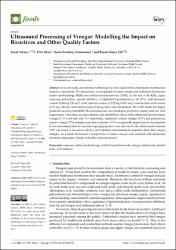Ultrasound Processing of Vinegar: Modelling the Impact on Bioactives and Other Quality Factors
Abstract
In recent years, non-thermal technology has been used for the enrichment of ultrasound
bioactive components. For this purpose, it was applied to tomato vinegar and modeled with response
surface methodology (RSM) and artificial neural network (ANN). At the end of the RSM, cupric
reducing antioxidant capacity (68.64%), 1,1-diphenyl-2-picrylhydrazyl (62.47%), total flavonoid
content (2.44 mg CE/mL), total phenolic content (12.22 mg GAE/mL), total ascorbic acid content
(2.53 mg/100 mL) and total lycopene (5.44 µg/mL) were determined. The ANN model has higher
prediction accuracy than RSM. The microstructure, microbiological properties, sensory analysis, ACE
(angiotensin-converting–enzyme) inhibitor and antidiabetic effects of the ultrasound-treated tomato
vinegar (UTV) (8.9 min and 74.5 amplitude), traditional tomato vinegar (TTV) and pasteurized
tomato vinegar (PTV) samples were then evaluated. UTV was generally appreciated by the panelists.
It was determined that the microbiological properties were affected by the ultrasound treatment.
UTV was found to have more effective ACE inhibitor and antidiabetic properties than other vinegar
samples. As a result, the bioactive components of tomato vinegar were enriched with ultrasound
treatment and positive effects on health were determined.
Volume
10Issue
8Collections
The following license files are associated with this item:


















